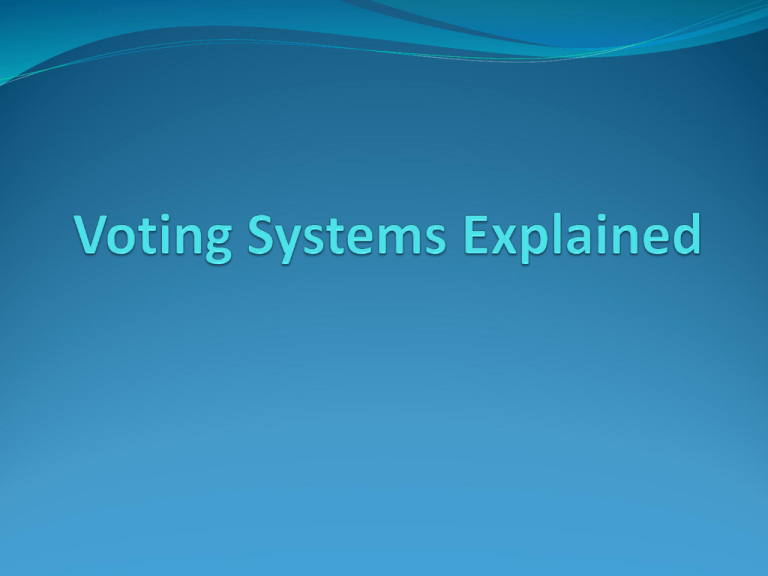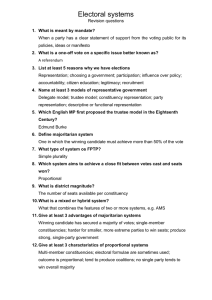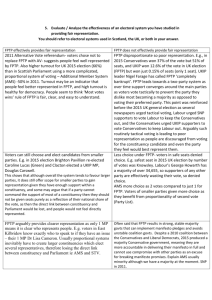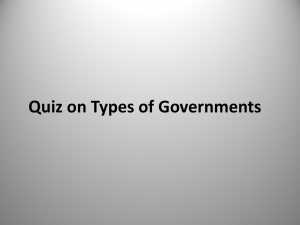File - THS Modern Studies
advertisement

What is a voting system? Elects MPs to Parliament. Various forms used in different countries. Key Words • Legislature: a body that looks at, amends and rejects/approves laws. • Reichstag: the lower house of the German Parliament. It was fully elected by people over 20 and formed the government. • Reichsrat: the Reich council. It represented the states, indirectly elected by the Ländesrats of Germany. 67 members. • Ländesrat: the state legislature/assembly. Had powers in areas like Education. • Parliamentary Government: the government is the majority party/parties in the Reichstag. House of Commons Seating Arrangement What voting systems are there? There are three main groups of voting system: Majoritarian: a system that elects MPs using a majority. Be it a simple majority (whoever has the most votes wins (FPTP)) or a normal majority (50% +1 vote (AV)). Use single member seats. Systems: FPTP; AV; SV; and SB. Proportional: a system that elects MPs based on the % of the vote they get. E.g. 20% votes = 20% seats. Use multimember seats. Systems: List and STV. Hybrid: a system that does a mix of the above two systems. So 50% seats by PR and 50% by FPTP. Systems: AMS and AV+. Majoritarian - FPTP FPTP = First Past the Post. It elects MPs in single member constituencies. You put an “X” by the candidate you like. E.g. If there was an election tomorrow in the Lancing constituency and the votes were as follows: Party A: 10,000 - elected Party B: 7,000 Party C: 3,000 Party A’s candidate is elected because he has the most votes. This is the system used in the UK. Advantages & Disadvantages Advantages It is simple to use and understand. There is a constituency link. Provides for strong government. Reduces the representation of fringe parties. Disadvantages It is not proportional. Tyranny of democracy – too strong a govnt. Minority’s choice, not the majority’s. It makes it harder for third and other parties to gain representation even with 23% of the vote. E.g. Lib Dems have only 57 seats (8%) with 23% of the vote. Majoritarian – AV,SV and SB AV = Alternative Vote. It elects MPs in single member constituencies. (all Majoritarian systems do). No “X” this time. You number candidates “1”, “2” “3” in order of preference. To get elected you need 50% of the votes +1 to get elected. If no one achieves 50% +1 then the candidate with the lowest votes is eliminated. This keep happening until one candidate achieves 50% +1. Proposed by the Coalition and used in Australia. Majoritarian – AV,SV and SB 2 SV = Supplementary Vote. Same as above except if no one gets 50% +1 then only the top two candidates remain. Used in the London Mayoral elections. SB = Second Ballot. Same as above, but if no one achieves 50% +1 then a second ballot is held with the top two candidates. Used in French Presidential elections. Advantages & Disadvantages Advantages Majority’s choice, not the minority’s. Still provides strong govnt. Still provides a constituency link. Easy to understand and use – if you can count to 5… Disadvantages Still not proportional. Does little to account for representation issue. Still can fall prey to tyranny of democracy. Proportional - List The list system lists candidates and/or parties. Votes are by preference as with AV. Seats are, however, distributed by % of vote achieved. Uses multi-member constituencies. E.g. If party A get 20% of the vote, it gets 20% of the seats. Used by Germany until 1933. The list system has two versions: Open: parties and candidates are listed. More candidate- centric than closed. Closed: parties only listed. Candidates are on party lists. The higher you are on the list the more likely you are to be elected. Advantages & Disadvantages Advantages It is proportional in the purest of forms. It provides representation for smaller parties. Cooperation is necessary because it is hard to get a majority. Disadvantages Weak government occurs. Fringe parties can gain representation. No constituency link. Proportional - STV STV = Single Transferable Vote. Elects MPs in multi-member constituencies. Uses a quota to elect MPs based on a formula. If the candidate achieves the quota, they are elected. If they go over the quota their votes are redistributed. If no candidate gets the quota then the candidate with the lowest vote is eliminated. Used for NI Assembly elections. Advantages & Disadvantages Advantages It is proportional. It provides representation for smaller parties, but does makes it harder for fringe parties to get in. Constituencies are of a reasonable size in comparison to other PR systems. Disadvantages Constituencies are still in 100,000s. Weak government still occurs. Hybrid - AMS AMS = Additional Member System. Uses a mix of multi-member and single member constituencies. The ratio is not fixed. i.e. it could be 50-50, 60-40 etc. The candidates in the multi-member constituencies are elected using PR. The candidates in the single member constituencies are elected using FPTP. This system is currently used in Germany post-1945 and Scotland and Wales Assembly elections. Hybrid – AV+ AV+ = Alternative Vote Plus. Same as AMS, but the single member constituency voting system used is AV. This system is considered more proportional than AMS. This system is not currently used anywhere. Advantages & Disadvantages Advantages Best of both worlds – some MPs are proportionally elected and some have constituency link. Stronger government. Disadvantages Two classes of MP are created.











